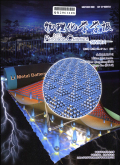物理化学学报2024,Vol.40Issue(5):46-49,4.DOI:10.3866/PKU.WHXB202307016
WO3/Zn0.5Cd0.5S S型异质结光催化产氢耦合有机物转化机理研究
Insights into Photocatalytic Mechanism of H2 Production Integrated with Organic Transformation over WO3/Zn0.5Cd0.5S S-Scheme Heterojunction
摘要
Abstract
Developing novel nanostructures to enhance the efficiency of solar-to-chemical conversion through integrated photocatalytic hydrogen(H2)evolution and organic transformation holds great promise in addressing pressing energy and environmental crises.Ternary metal sulfides have garnered considerable attention in photocatalytic H2 production due to their tunable bandgap and excellent visible light response.Among them,Zn0.5Cd0.5S stands out as a reduction photocatalyst with a narrow bandgap,a high conduction band level,and excellent resistance to photocorrosion.However,unitary Zn0.5Cd0.5S suffers from a high recombination rate of photogenerated electron/hole pairs,resulting in only a small fraction of charge carriers being involved in the photoreactions,leading to a low quantum efficiency that falls short of practical demand.WO3,a typical oxidation photocatalyst with a lower valence band position and strong oxidization ability,is an ideal candidate for constructing an S-scheme heterojunction with Zn0.5Cd0.5S.Herein,a core-shell structured WO3/Zn0.5Cd0.5S heterojunction with Zn0.5Cd0.5S nanosheets vertically growing out of WO3 nanofibers is fabricated through electrospinning and hydrothermal methods.The distinct disparity in work functions leads to the transfer of electrons from Zn0.5Cd0.5S to WO3 upon contact,creating an interfacial electric field(IEF)and simultaneously bending the energy bands at the interface.As a consequence of IEF,bent energy bands,and coulomb attraction,the photogenerated electrons in the conduction band of WO3 migrate to the valence band of Zn0.5Cd0.5S and recombine with its photoinduced holes,signifying the formation of an S-scheme heterojunction between WO3 and Zn0.5Cd0.5S and enabling efficient separation of powerful charge carriers,as evidenced by in situ irradiated X-ray photoelectron spectroscopy,electron paramagnetic resonance,and time-resolved fluorescence spectroscopy analyses.Benefiting from the unique S-scheme photocatalytic mechanism,along with the effective chemisorption and activation of reactants on the catalyst,the optimized WO3/Zn0.5Cd0.5S heterostructures exhibit exceptional photocatalytic performance in H2 production(715 μmol∙g-1∙h-1)and the transformation from lactic acid to pyruvic acid without the need for any noble metal cocatalyst,achieving the full utilization of photoinduced electrons and holes.In situ diffuse reflectance infrared Fourier transform spectroscopy,as well as density functional theory simulations,reveal the photoreaction mechanism of H2 production and organic transformation.This work offers valuable insights into the design and investigation of the mechanism behind novel S-scheme heterojunction photocatalysts,enabling high-performance H2 production and simultaneous organic transformation.关键词
三氧化钨/S型异质结/产氢/有机物转化/化学吸附与活化Key words
Tungsten oxide/S-scheme heterojunction/Hydrogen production/Organic transformation/Chemisorption and activation分类
化学引用本文复制引用
曹爽,钟博,别传彪,程蓓,徐飞燕..WO3/Zn0.5Cd0.5S S型异质结光催化产氢耦合有机物转化机理研究[J].物理化学学报,2024,40(5):46-49,4.基金项目
This work was supported by the National Key Research and Development Program of China(2022YFB3803600,2022YFE0115900),National Natural Science Foundation of China(52003213,22238009,22261142666,52073223,22278324,51932007),and the Natural Science Foundation of Hubei Province of China(2022CFA001). 国家重点研究与发展计划(2022YFB3803600,2022YFE0115900),国家自然科学基金(52003213,22238009,22261142666,52073223,22278324,51932007)以及湖北省自然科学基金(2022CFA001)资助 (2022YFB3803600,2022YFE0115900)

